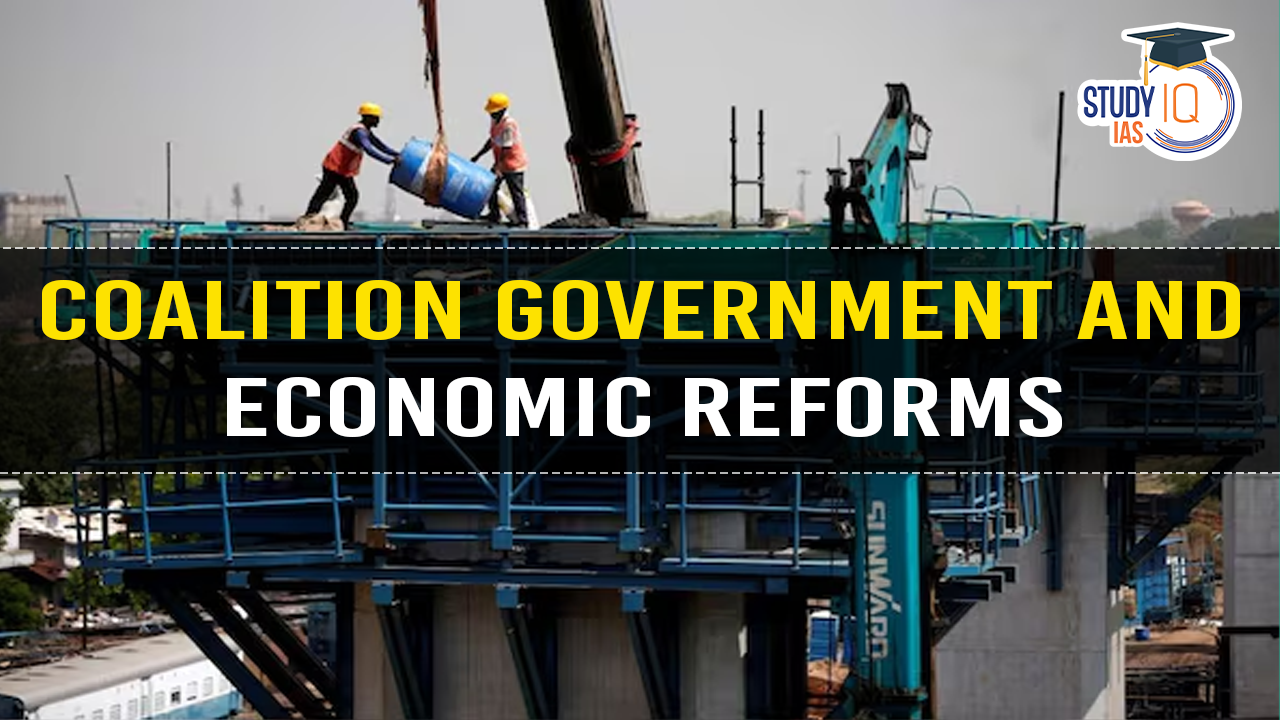Table of Contents
Context: The National Democratic Alliance (NDA) has secured a third consecutive term in power at the Centre, although the BJP on its own did not reach the majority threshold of 272 seats. This situation indicates that a true coalition government will be formed.
What is a Coalition Government?
- A coalition government involves multiple political parties coming together to form a power-sharing executive branch.
- These governments typically form when no single party secures an absolute majority in an election, necessitating partnerships to achieve a governing majority.
- Coalitions are more common under proportional representation systems where it’s difficult for one party to win an outright majority, unlike in majoritarian electoral systems.
- Independent India’s first experience with a coalition government at the Centre occurred in 1977 following the Emergency period.
- The first coalition government in India to complete a full five-year term was led by the Bharatiya Janata Party (BJP) under the National Democratic Alliance, with Atal Bihari Vajpayee as the Prime Minister from 1999 to 2004.
Impact of Coalition Governments on Economic Reforms in India Since 1991
Historical Context
Post-1991, India transitioned from a planned to an open economy, with all subsequent governments being coalitions as no single party achieved a majority. Montek Singh Ahluwalia noted that these governments often faced a “strong consensus for weak reforms” due to their inherent structure.
Challenges Faced by Coalition Governments
- Diverse Agendas: Coalition partners typically have different political and economic priorities, which can result in compromises and watered-down reforms.
- Consensus Building: While coalitions can encourage a broader consensus, the need to satisfy multiple parties may lead to weaker and less effective economic measures.
- Policy Stability: Changes in coalition dynamics or internal disagreements can cause policy fluctuations, undermining investor confidence and complicating long-term economic planning.
Notable Reforms Under Coalition Governments
Despite challenges, several significant economic reforms were implemented by coalition governments, including the introduction of the Goods and Services Tax (GST) and the Insolvency and Bankruptcy Code.
Counterexamples and Setbacks
- Some initiatives, like land acquisition reforms and farm laws, faced setbacks or were repealed due to opposition and protests.
- The demonetization initiative in 2016 introduced by PM Narendra Modi’s government, while intended to curb corruption, resulted in economic disruptions.
Conclusion on Coalition Governments and Economic Reforms
- It is incorrect to assert that coalition governments necessarily derail India’s economic reform trajectory.
- Historical evidence shows that coalitions have been capable of undertaking significant reforms that have contributed to India’s economic growth.
- Effective leadership, strategic compromise, and clear communication are crucial for coalitions to overcome challenges and sustain reform momentum.
Significant Reforms Introduced by Previous Coalition Governments in India
P V Narasimha Rao Government (Economic Liberalisation)
- Economic Reforms: Initiated a shift from centralised planning, opening up the economy to international markets and eliminating the licence-permit system.
- Global Integration: India joined the World Trade Organization during Rao’s tenure, integrating further into the global economy.
Deve Gowda Government (The “Dream Budget”)
- Tax Reforms: Finance Minister P. Chidambaram’s budget significantly reduced personal and corporate tax rates, and customs duties, enhancing the trust of Indian taxpayers.
Atal Bihari Vajpayee Government (Fiscal and Infrastructure Reforms)
- Fiscal Responsibility: Implemented the Fiscal Responsibility and Budget Management (FRBM) Act to curb government borrowing and enforce fiscal discipline.
- Disinvestment and Infrastructure: Promoted the disinvestment of unprofitable public sector units and enhanced rural infrastructure through initiatives like the Pradhan Mantri Gram Sadak Yojana.
- Information Technology Act 2000: Established the legal framework necessary for the growth of e-commerce in India.
Manmohan Singh Government (Rights-Based Reforms)
- Education Reforms: Built on the Sarva Shiksha Abhiyan with the Right to Education Act, aiming to provide universal education to all children.
- Transparency and Welfare: Introduced the Right to Information Act and the Right to Food, and implemented the Mahatma Gandhi National Rural Employment Guarantee Act (MGNREGA) to bolster transparency and welfare.
- Economic and Technological Advances: Moved towards deregulation of fuel prices, initiated direct benefit transfers and laid the groundwork for Aadhaar and the Goods and Services Tax (GST) implementation.


 Why India Needs Its Own Economic Model?
Why India Needs Its Own Economic Model?
 Challenges in India’s Airline Sector: ...
Challenges in India’s Airline Sector: ...
 Forest Conservation Act, 1980: Objective...
Forest Conservation Act, 1980: Objective...

























